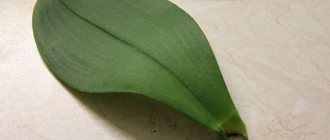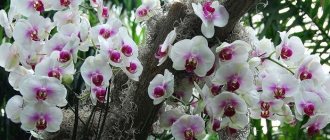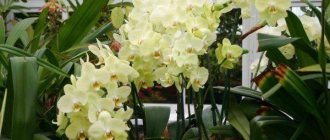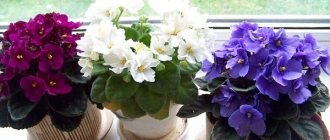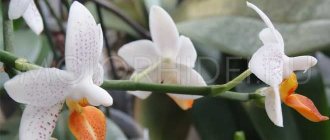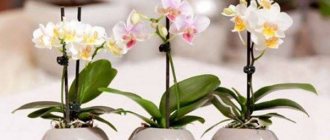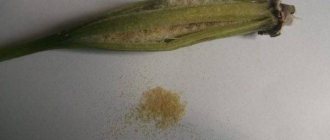Catalog of popular colors
Ceramic pots are not suitable for phalaenopsis orchids. These pots are best used as decorative vases. Thin-walled plastic but opaque pots will not work either.
A pot for a phalaenopsis orchid must be transparent or translucent, since the roots of the orchid, like the leaves, participate in photosynthesis of light.
A transparent pot is also needed to control soil moisture. If droplets of water or evaporation are visible inside on the wall of the pot, then there is no need to water it yet. After watering, drain excess water from the tray.
In addition, there should be holes at the bottom of the pot so that after watering, moisture should not accumulate at the bottom of the pot.
What kind of pot is needed for a phalaenopsis orchid.
Materials from which growing containers are made
Glass
Glass planters are very beautiful, but they have a number of disadvantages :
- Does not maintain temperature during sudden changes in temperature;
- Container weight;
- Fragility;
- Price;
- A small number of different forms.
Despite the fact that there are certain inconveniences, many gardeners still prefer to grow flowers in glass flowerpots .
Ceramics
Only experienced gardeners can afford to cultivate the plant in ceramic pots . Because you need to determine the time of watering. Typically, gardeners look at the condition of the roots; they will immediately have to water based on their intuition.
When transplanting, very often the velamen of the roots grows to the walls of the pot , and then you have to sacrifice the pot or the root system of the flower when replanting.
How to plant a plant in a pot without drainage holes
Some pots have drainage and others don't (we usually call them "planters"). It's a pretty simple distinction, and yet that little hole in the bottom of your pot makes a world of difference in terms of potting, plant care and maintenance.
How to plant in pots without drainage holes? Can?
Some people say this shouldn't be done at all, arguing that drainage holes are critical to plant health. So is it possible to keep a plant in a pot without drainage holes?
Our answer: YES, but with caution.
You need to control the amount of water going into your pot; If such a plant gets caught in a rainstorm, it will most likely die, so such pots in the garden can only be placed under cover.
What is the purpose of the drainage hole?
All plants need water to survive. Yet overwatering is the most common (and perhaps most effective) way to kill a houseplant. Drainage holes allow excess water to seep out of the pot after watering without water pooling at the base of the pot, which helps protect sensitive roots from fungus and bacteria.
Planting rules: pots without drainage holes
Every drop of water you add to your planter will stay there. While it is usually recommended to completely saturate the plant with water when watering, in a pot without drainage you need to water a little and slowly so that the water flows evenly through the soil and does not accumulate at the bottom.
Creating a drainage layer
The drainage layer is usually pebbles, gravel, or pebbles. Coarse soil is best suited for an aquarium. Soil particles are very small and pack tightly together, which means water moves through them quite slowly. The drainage layer has more space between the particles, allowing water to flow through quickly.
Adding a drainage layer allows excess water to move out of the soil and away from the roots more quickly. Although the water is still in the pot, a drainage layer can provide a barrier between excess water and your plant. And then gradually flow to the roots, as if from your own reservoir.
Use of activated carbon
The best solution for the drainage layer is activated carbon. Activated carbon is heated at high temperatures, which enhances its natural absorption properties. This means that a layer of activated carbon at the bottom of your pot is actually effective at removing some of the excess water. This way you don't flood the plant. This type of carbon is sold in large packages for aquariums and is also suitable for plants.
Additionally, another problem that occurs due to overwatering is fungal and bacterial diseases. Activated carbon has natural antimicrobial properties. Additional benefit!
Think you've overwatered the plant? Flip and drain!
Hold the soil with your hand and gently tilt the pot (or even turn it all the way upside down if possible) to release excess water. If you have drained some of the soil, just add some fresh soil.
Right size
More soil means more moisture, which will take longer to dry. You need to replant the plant to a larger pot with a diameter only 3-4 cm larger
. This is especially important when you have pots without drainage holes, as without root mass to fill your pot, all that soil will remain soggy even longer, leading to unintentional overwatering.
If you fail, replant
Listen to your plant. Some plants do well in drainless pots, while others do not so much. If the plant is not feeling well, carefully remove it from the pot and look at the roots. Black or brown, fluffy roots are a sign of overwatering. Try trimming off any damaged roots and replanting the potted plant in a pot with drainage holes, keeping the soil just slightly moist until signs of recovery appear.
Flowerpot and pot: what's the difference
Orchids, like other flowers in apartments, are often grown in flower pots. Beautiful compositions add additional charm to tropical beauties and look presentable and stylish. The design of the pots is different; it is not a pot in the usual sense of the word.
Features of the pot:
- performs a decorative and protective function;
- the plant is in a double container (there is a layer for air);
- walls without drainage holes;
- various materials are used (plastic, wood, ceramics, plaster, plastic)
- larger than the pot in size.
Place a container with a plant in the container, maintaining the space between their walls. The air gap prevents moisture accumulation. It’s easy to make a designer flowerpot for orchids with your own hands.
Diseases
Excess moisture due to improper watering of plants leads to the fact that water displaces air from the soil, and harmful bacteria begin to develop there, causing flower disease. To avoid this, it is recommended to place special drainage made of expanded clay, crushed stone, gravel or polystyrene at the bottom of the pot, and also pay attention to the location of the holes in the container.
When choosing flower pots, you should pay attention not only to the design, but first of all to its material, shape and number of holes. The presence of the latter is especially important for the safety of the plant’s root system. Pay attention not only to the presence of drainage holes, but to their size and number. They should be predominantly equidistant and have an average size in diameter.
- Author: Inna Kiseleva
What can be used as drainage for flowers?
How to replace drainage for indoor plants: gravel, crushed stone (brick, gravel, slag, limestone, etc.), coarse sand, polystyrene foam, hydrogel, stones from the yard, broken clay shards, charcoal, bark.
Interesting materials:
What grows in the berry forest? What grows from berries in the forest? What grows in the forest: wild strawberries or strawberries? What grows in the greenhouse? What grows in the Rostov region? What grows on palm trees? What is a kumquat and where does it grow? What are the main models of economic growth? Where do most oranges grow? Where do beans grow most?
Root rotting
Often this problem occurs due to irregular watering; drying out of the earthen clod and its subsequent waterlogging causes a painful reaction in the roots of the plants.
The result of rotting of the root system is the falling and darkening of leaves, and in advanced cases, the death of the plant. A properly selected pot with drainage holes, preferably made of clay, since this material allows air to pass through well, will help regulate the flow of liquid and provide the necessary air exchange for the roots of the flower.
You can make an orchid pot yourself
You can make an orchid pot yourself, for example, from any transparent plastic container or plastic bottle. In this case, we will make a pot for an orchid from a container that contained liquid soap.
Carefully and carefully cut off the top of the bottle. It's safer to cut with scissors. The bottle is too long and the top cut can be decorated, for example, by cutting out the corners and bending them. A homemade orchid pot differs from a factory one in the quality of plastic, but it can be beautifully decorated.
The plastic container for the orchid pot should be quite rigid. You must make holes on the bottom. The holes need to be widened using edged scissors. Be careful, you might get hurt.
Video on how to make an orchid pot with your own hands.
Buy a blooming phalaenopsis orchid
You can buy one blooming orchid, depending on the size of the plant and the diameter of the pot, in the range from 800 to 1000 rubles.
We will tell you the exact price of each orchid when you contact us. Delivery of orchids by mail is possible free of charge (at our expense) if the cost of the ordered plants (a set of any flowers, seedlings or seeds, including orchids) is 3,000 rubles or more. The minimum purchase amount for orchids is 1000 rubles. Please note that in this case the parcel is paid for by you and this amount is added to the cost of the orchid additionally.
We do not send parcels by cash on delivery!
Catalog of orchids with photos and brief descriptions.
For the availability of certain varieties and types of orchids in our nursery at the moment, see the “Orchid Catalog” section (click on the link or photo above this text) or in the section: Buy an orchid in a pot by mail.
When ordering orchids you only need to indicate the flower number
It is advisable to send an application for the purchase of orchids in writing by mail. We can also accept applications by phone 89379684236 from 10.00 to 20.00 (Moscow time).
Other articles and descriptions of plants:
Orchid in a pot: how to care for an orchid
Home orchid planted in a pot. How to care for an orchid at home. Tips for replanting, watering and nursing in case of illness. Photos of flowers of different varieties of orchids.
Artificial pollination of flowers by hand
In this article you will learn how to artificially pollinate plants at home. Hand pollination of flowers.
Propagation of abutilone by cuttings
In this article you will find recommendations on how to grow and propagate abutilon or indoor maple at home using cuttings.
How to make a greenhouse with your own hands
In this article we will show you how to make a small greenhouse or greenhouse for growing vegetables in the country. You will learn what materials can be used to build such greenhouses.
Hibiscus: description, planting and care
In our plant and seed nursery you can buy hibiscus seedlings. In addition, you will find information on how to grow and care for it.
Clematis - planting and care
Description of the most popular types of clematis. Recommendations from an experienced gardener for planting, growing and caring for clematis.
Campsis: planting and growing
How to properly plant Kampsis liana in the middle zone. Caring for the campsis flower and preparing a heat-loving vine for the winter.

